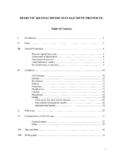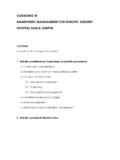Transcription of Part 2: Intracranial pressure (ICP) - Anaesthesia UK
1 cerebral Blood Flow and Intracranial PressureDr Lisa Hill, SpR Anaesthesia , Royal Oldham Hospital, Carl Gwinnutt, Consultant Neuroanaesthetist, Hope Hospital, 2: Intracranial pressure (ICP)As mentioned in the previous tutorial, Intracranial pressure is important as it affectscerebral perfusion pressure and cerebral blood flow. Normal ICP is between 5 and13mmHg. Because it is very dependant on posture, the external auditory meatus isusually used as the zero facts and figures:- Constituents within the skull include the brain (80%/1400ml), blood (10%/150ml)and cerebrospinal fluid (CSF 10%/150ml) The skull is a rigid box so if one of the three components increases in volume, thenthere must be compensation by a decrease in the volume of one or more of theremaining components otherwise the ICP will increase (Monro-Kellie hypothesis).
2 The term compliance is often used to describe this relationship, but it is moreaccurately elastance (change in pressure for unit change in volume) Compensatory mechanisms include movement of CSF into the spinal sac, increasedreuptake of CSF and compression of venous sinuses. These mechanisms reduce theliquid volume of the Intracranial contents Figure 5. ICP elastance curve (change in pressure per unit change in volume)Stage 1/2 = compensation phase. As one of the Intracranial constituents increases involume, the other two constituents decrease in volume in order to keep the intracranialpressure 3/4 = decompensated phase. When compensatory mechanisms are exhausted,small increases in the volumes of Intracranial constituents cause large increases in slope of the curve is dependent on which Intracranial constituent is increasing.
3 If itis blood or CSF, both of which are poorly compressible, then the slope is steeper. If it isbrain tissue, such as from a tumour, the curve is less steep as the tissue is Fluid (CSF)CSF is a specialised extracellular fluid in the ventricles and subarachnoid space whichhas a multitude of functions:- Mechanical protection by buoyancy. The low specific gravity of CSF ( ) reducesthe effective weight of the brain from to 47g (Archimede s principle). Thisreduction in mass reduces brain inertia and thereby protects it against deformationcaused by acceleration or deceleration forces CSF provides a constant chemical environment for neuronal activity CSF is important for acid-base regulation for control of respiration CSF provides a medium for nutrients after they are transported actively across theblood-brain-barrierIt is produced at a rate of (500ml/day) by the choroid plexus in the lateral,third and fourth ventricles.
4 CSF is produced by the filtration of plasma throughfenestrated capillaries followed by active transport of water and dissolved substancesthrough the epithelial cells of the blood-CSF barrier. This is distinct from the blood-brain-barrier which consists of endothelial cells linked by tight junctions whose functionis to protect the brain from chemicals in the blood stream. CSF formation is dependenton the CPP and when this falls below 70mmHg, CSF production also falls because of thereduction in cerebral and choroid plexus blood flow. Following production, CSF thencirculates through the ventricular system and the subarachnoid spaces, aided by ciliarymovements of the ependymal cells. Resorption takes place mostly in the arachnoid villiand granulations into the circulation: the mechanism behind the resorption is thedifference between the CSF pressure and the venous pressure .
5 An obstruction in CSFcirculation, overproduction of CSF or inadequate resorption results in of Plasma and CSFP lasma mmol/lCSF (fasting) 6. Production, circulation and resorption of CSF. Production mostly takes placein the choroid plexus of the lateral ventricles. CSF circulates to the subarachnoid spaces,where resorption takes place via the arachnoid granulations and villi. When ICP israised, the pressure is transmitted along the optic nerve causing papilloedema. ( )Pathological Conditions Causing a Rise in Volume of Intracranial ConstituentsAny of the three Intracranial constituents (tissue, blood or CSF) can increase in size TissueBloodCSF- Tumours- cerebral oedema secondaryto trauma, infection, infarction,hyponatraemia, hypertensiveencephalopathy, acute liverfailure, Reye s syndrome- cerebral abcesses- cerebral contusions- Intracerebral, subarachnoid,subdural, extradural haematomas- Arteriolar dilatation secondary tohypoxaemia, hypercarbia,anaesthetic drugs, hyperthermia,seizures, hypotension- Venous dilatation secondary tovenous obstruction from highPEEP, coughing, straining, heartfailure, venous sinus thrombosis,head-down tilt, tight neck ties- Hydrocephalus- Meningeal diseases- Choroid plexus tumoursEffects of a Raised ICPAs ICP rises.
6 CPP falls eventually to a point when there is no cerebral blood flow, nocerebral perfusion and brain death. Prior to this, brain structures begin to herniate(protrude through an opening). Physiological compensatory mechanisms occur to try andmaintain cerebral blood flow:-1. Temporal lobe herniation beneath tentorium cerebelli (uncal herniation) causescranial nerve III palsy (dilatation of pupil followed by movement of eye down and out).2. Herniation of cerebellar peduncles through foramen magnum (tonsillar herniation). pressure on the brainstem causes the Cushing reflex hypertension, bradycardia andCheyne-Stokes respiration (periodic breathing).3. Subfalcine herniation occurs when the cingulate gyrus on the medial aspect of thefrontal lobe is displaced across the midline under the free edge of the falx cerebri andmay compress the anterior cerebral Upward, or cerebellar herniation occurs when either a large mass or increasedpressure in the posterior fossa occurs.
7 The cerebellum is displaced in an upwarddirection through the tentorial opening and causes significant upper can ICP be influenced?Primary brain damage occurs at the time of a head injury and is unavoidable exceptthrough preventative measures. The aim of management following this is to reducesecondary brain damage which is caused by a reduction in oxygen delivery due tohypoxaemia (low arterial PaO2) or anaemia, a reduction in cerebral blood flow due tohypotension or reduced cardiac output, and factors which cause a raised ICP and most important management strategy ensures A (Airway and C spine protection), B(Breathing and adequate oxygenation) and C (blood pressure and CPP). Following this,further strategies to reduce ICP and preserve cerebral perfusion are required.
8 Techniquesthat can be employed to reduce ICP are aimed at reducing the volume of one or more ofthe contents of the brain tissue volumeReduce blood volumeReduce CSF volume-Tumour resection, abcessremoval-Steroids (especiallydexamethasone) to reducecerebral oedema-Mannitol/furosemide to reduceintracellular volume-Hypertonic saline to reduceintracellular volume- Decompressive craniectomyto increase Intracranial volume- Evacuation of haematomas- Arterial: avoiding hypoxaemia,hypercarbia, hyperthermia,vasodilatory drugs, hypotension- Barbiturate coma to reduce CMRO2and cerebral blood volume- Venous: patient positioning with 30 head up, avoiding neck compressionwith ties/excessive rotation, avoidingPEEP/airway obstruction/CVP linesin neck- Insertion of externalventricular drain orventriculoperitonealshunt to reduce CSFvolume (more long termmeasure)If ICP is not measured directly, we can estimate it and therefore make changes in MAP tomaintain CPP-o Patient drowsy and confused (GCS 9-13) ICP 20mmHgo GCS 8 ICP 30mmHgOften, blood pressure needs to be augmented with drugs that produce arterialvasoconstriction such as metaraminol or noradrenaline (which requires central venousaccess).
9 Following a head injury when autoregulation is impaired, if there is a drop inMAP from drugs or blood loss, the resulting cerebral vasodilatation increases cerebralblood volume which in turn raises ICP and further drops CPP. This starts a vicious by raising MAP, ICP can often be ICPICP is traditionally measured by use of a ventriculostomy, which involves a catheter thatis placed through a small hole in the skull (burr hole) into the lateral ventricle. ICP isthen measured by transducing the pressure in a fluid column. Ventriculostomies alsoallow for drainage of CSF, which can be effective in decreasing the ICP. Morecommonly ICP is now measured by placing some form of measuring device (for examplea minature transducer) within the brain tissue (intraparenchymal monitor).
10 An epiduralmonitor can also be used but becomes increasingly unreliable at extremes of normal ICP waveform is a triphasic wave, in which the first peak is the largest peakand the second and third peaks are progressively smaller. When Intracranial complianceis abnormal, the second and third peaks are usually larger than the first peak. In addition,when Intracranial compliance is abnormal and ICP is elevated, pathologic waves mayappear. Lundberg described 3 types of abnormal ICP waves in 1960, that he named A, B,and C waves. Although these can be identified, it is more common nowadays to measurethe mean ICP and use this to calculate the Adequacy of cerebral PerfusionThis is difficult as ideally adequacy of cerebral perfusion would be determined at acellular level to determine whether neurones are receiving adequate oxygen and about cerebral perfusion can be made by looking at a variety of measuredvariables.














